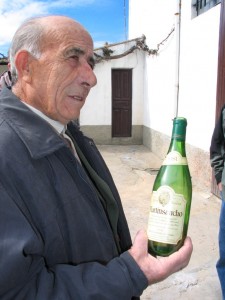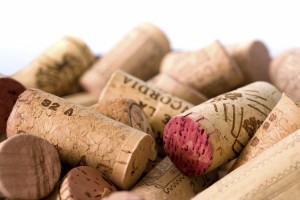 On a recent visit to Spain I had the opportunity to spend time with Angel Rodriquez, one of Spain’s most revered winemakers. Anyone who has met Angel Rodriguez stands in awe of his tremendous accomplishment. Visiting this spry, witty 83 year old winemaker and his beloved Martinsancho Vineyard is a rare treat and valuable lesson in the value of dedication, history, and wine. Angel’s story is the story of a unique grape called Verdejo. Although Verdejo is one of only a handful of truly noble Spanish white grape varietals, it was in serious danger of extinction by the early 1970s due to the pervasive planting of more prolific native varietals such as Viura and Palomino and the introduction of international favorites such as Chardonnay. Through his loving refusal to uproot his ancient 17th century vineyard called Martinsancho, Angel Rodriguez saved the delicious, but shy bearing Verdejo from extinction
On a recent visit to Spain I had the opportunity to spend time with Angel Rodriquez, one of Spain’s most revered winemakers. Anyone who has met Angel Rodriguez stands in awe of his tremendous accomplishment. Visiting this spry, witty 83 year old winemaker and his beloved Martinsancho Vineyard is a rare treat and valuable lesson in the value of dedication, history, and wine. Angel’s story is the story of a unique grape called Verdejo. Although Verdejo is one of only a handful of truly noble Spanish white grape varietals, it was in serious danger of extinction by the early 1970s due to the pervasive planting of more prolific native varietals such as Viura and Palomino and the introduction of international favorites such as Chardonnay. Through his loving refusal to uproot his ancient 17th century vineyard called Martinsancho, Angel Rodriguez saved the delicious, but shy bearing Verdejo from extinction
The original majuelo or 17th century vineyard of Martinsancho comprises less than two acres of ancient vines, all of which are in excess of 250 years of age. These gnarled, ungrafted vines grow out of a bed of stones over thirty feet deep, preserved in isolation as a museum of pre-phylloxera viticulture and a continuing source of undisputed varietal authenticity. Once considered an anachronism and an economic liability, nurseries throughout Europe now treasure the Martinsancho Vineyard and its beloved Verdejo for the vine cuttings it provided and the viticultural legacy it has preserved. Yet, more than forty years ago no one seemed to care about this old vineyard with its unprofitable, extremely low yielding vines; in fact, few had even heard of Martinsancho’s existence. Verdejo was on the verge of extinction as it was deemed not profitable enough then by most experts to preserve, let alone grow, despite the vine’s noble pedigree and the undisputed quality of the wine it produced. Yet, in spite of the prevailing pressure and “expert advice” to uproot the old vineyard, Angel Rodriguez preserved it, and then undertook the near impossible and what many have called sheer lunacy: he re-grafted Martinsancho’s Verdejo by hand into 25 acres of a nearby vineyard with nearly identical soil – a monolithic undertaking.
Subsequently, other Rueda growers have planted Verdejo with the help of Angel Rodriguez, to the point that today Verdejo is once again the leading white grape varietal in Rueda. For his great sacrifice and untiring efforts in favor of re-establishing Verdejo’s prominence in its region of origin, Angel Rodriguez has been officially honored by King Juan Carlos of Spain. Yet, in spite of his great accomplishment and the recognition that has followed, Angel Rodriquez remains a humble man who believes in tradition. He steadfastly maintains a very low-tech approach to the natural production of his wine, which is totally organic and includes little or no added sulfites – a rarity, especially among white wines. Look for Angel’s Rodriguez’s outstanding 2011 Martinsancho Verdejo in an upcoming feature.
Don


 True confessions, yes! Remorse, no, I don’t plan to lose any sleep over past transgressions, mine or anyone else’s. So, here it goes. Years ago, I loved Chardonnay, and then I just lost interest. At first, it was benign neglect. But then I found myself loathing quite a few Chardonnays, especially a certain breed of California Chardonnay with its propensity for flabbiness and preponderance of oak. At times, after tasting some of these wines I thought I would have to pick splinters from my mouth from the less than judicious use of raw wood. “Is this wine I’m drinking or oak water,” I asked myself. And honestly, I wasn’t sure. I began to hate such concoctions. Admittedly, there were exceptions and some extraordinary California Chardonnays that were not over-oaked or under-wined depending upon one’s perspective. And there were still many French white Burgundies (the original Chardonnay and my first Chardonnay love) that stood the test of time, but the cost of the finest French Burgundies went through the roof in the 1990s and have kept on soaring to the point where such classics are now the exclusive domain of multi-millionaires and billionaires, which precludes me and nearly the rest of the planet, too. I still get to taste these Burgundian classics on occasion, but purchasing them is out of the question. Too bad, but aside from the ridiculous cost, the payback just isn’t that great . . . most of the time.
True confessions, yes! Remorse, no, I don’t plan to lose any sleep over past transgressions, mine or anyone else’s. So, here it goes. Years ago, I loved Chardonnay, and then I just lost interest. At first, it was benign neglect. But then I found myself loathing quite a few Chardonnays, especially a certain breed of California Chardonnay with its propensity for flabbiness and preponderance of oak. At times, after tasting some of these wines I thought I would have to pick splinters from my mouth from the less than judicious use of raw wood. “Is this wine I’m drinking or oak water,” I asked myself. And honestly, I wasn’t sure. I began to hate such concoctions. Admittedly, there were exceptions and some extraordinary California Chardonnays that were not over-oaked or under-wined depending upon one’s perspective. And there were still many French white Burgundies (the original Chardonnay and my first Chardonnay love) that stood the test of time, but the cost of the finest French Burgundies went through the roof in the 1990s and have kept on soaring to the point where such classics are now the exclusive domain of multi-millionaires and billionaires, which precludes me and nearly the rest of the planet, too. I still get to taste these Burgundian classics on occasion, but purchasing them is out of the question. Too bad, but aside from the ridiculous cost, the payback just isn’t that great . . . most of the time.